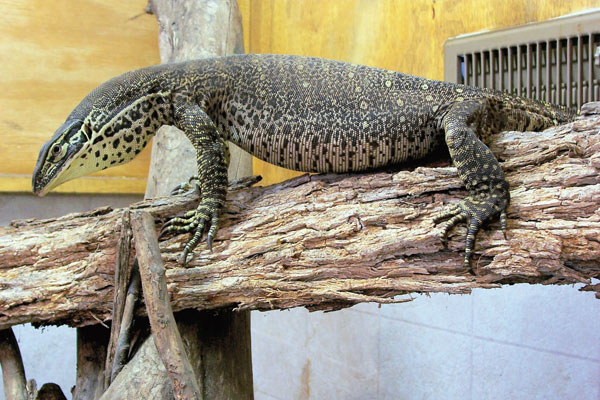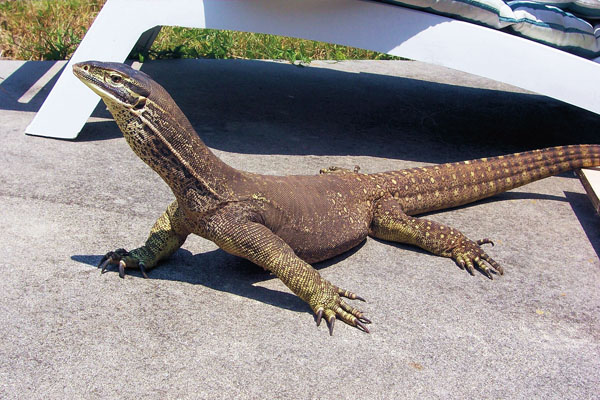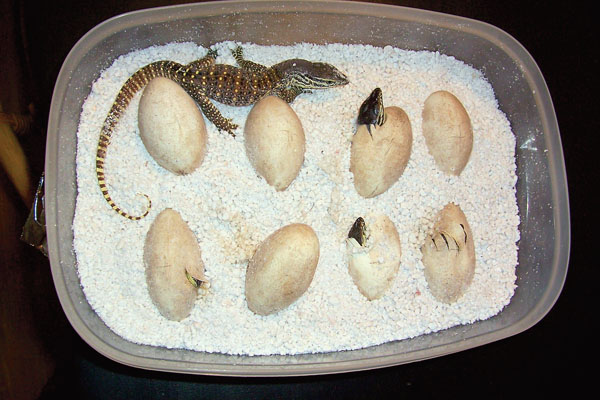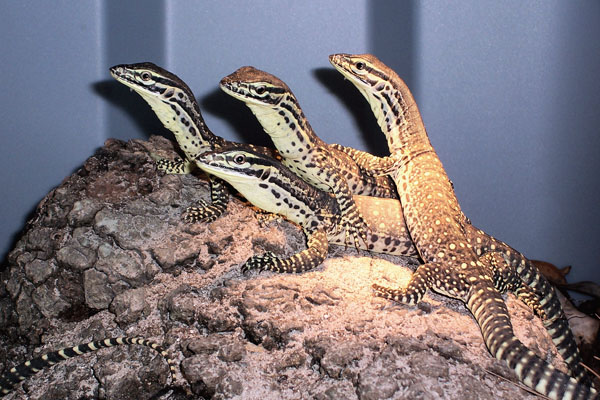There's never a dull moment when keeping Varanus panoptes horni.
Unfortunately, many people who want to keep the giants of the lizard and snake worlds fail to understand the care requirements and sheer size of the adult animals. The neonates of many large monitor lizards are adorable little clones of their adult counterparts, often exhibiting the same rugged character and charisma. Monitors, in particular, present themselves as intelligent animals that seem to be thinking and solving things as they stare back at you. Many will hold their ground and show their "spirit" when you attempt to hold them.
Luckily, the Argus monitor (Varanus panoptes horni) is a relatively manageable species that does not get as huge as other monitors, normally remaining less than 5 feet in length. It has an intense personality, is not particularly shy, and is just large enough to be considered a behemoth pet lizard for show, but not so large that it cannot be housed and cared for by an intermediate to advanced keeper with the proper resources and dedication. For this reason, the Argus monitor has become quite a popular pet monitor lizard in recent years.

The Argus monitor is a relatively manageable species that does not get as huge as other monitors, normally remaining less than 5 feet in length.
Natural History and Description
The Argus monitor is endemic to the Papuan island, both Indonesia and New Guinea, along the southern coastal and lowland interior ranges. It is often found in savannah grasslands, riparian habitats, woodlands, coastal regions and floodplains. It is a mostly terrestrial lizard that digs burrows. It will sometimes climb and may use tree hollows to some degree, but adult Argus monitors are clumsy climbers compared to other monitor species more adapted to arboreal lifestyles. It is a decent swimmer and will often hunt in shallow floodplains, ponds and waterways.
An Argus monitor's front limbs are very powerful and large for efficient digging. Capable of running at high speeds, an Argus will often lift its front legs off the ground while fleeing danger, using the tail as a balance much like a gigantic basilisk or frilled lizard. Another impressive trait is its ability to stand erect – to "tripod" up on its hind legs and tail – allowing it to survey the landscape from a higher vantage point. Captive Argus monitors will often display this interesting behavior, and it's fascinating to witness.
Hatchling Argus monitors generally measure 10 to 12 inches in total length and are more brilliantly colored and patterned than the adults. They exhibit an off-white, yellow or yellow-green background coloration with a dark brown to black dorsum and yellow ocelli forming transverse bands. Reddish-brown and/or gray markings may appear dorsally. The tail is always ringed with dark brown transverse bands that extend to its tip. Some of the Australian V. p. panoptes and V. p. rubidus localities will have a pure yellow tail tip on the distal third while others do not, but all specimens of V. p. horni that I have observed always have banding to the tip of the tail.
An average fully grown adult male Argus is a sturdily built animal nearly 5 feet in total length. Females generally max out at about 31/2 feet. Males have greatly enlarged "Popeye" front legs compared to the females. Color and patterning is identical in the two sexes. It's theorized that the males develop so much larger as an adaptation of ritualized combat during the breeding season. Males will congregate in areas of receptive females and engage in standing pushing matches of strength. Winners stay to mate with the nearby female, and the loser is driven away. Therefore, larger males are selected for over time as they are passing on their genetic material more often. The same upright combat is well-known and described in several other monitor lizard species, including the Komodo (V. salvator).

An Argus monitor's front limbs are very powerful and large for efficient digging.
Enclosures for Neonates and Adults
The Argus monitor is relatively easy to keep as a pet provided some basic care requirements are met. By monitor standards, it is a very hardy captive goanna. Start baby Argus monitors off in an enclosure that is at least 36 inches long, 30 inches tall and 18 inches wide. Provide at least 6 inches of substrate. I like to use Exo-Terra glass terrariums as "raise-up" cages for baby Argus monitors. There is room for several inches of substrate, glass doors on the front that open out, and space for lighting on top. I place plexiglass over some of the screen panels on the top to retain heat and humidity.
I don't recommend an all-screen top for an Argus monitor habitat. The constant convection of heat and humidity out the top of the cage is inefficient and dehydrates the young lizards. It's better to have a good portion, if not all, of the top of a terrarium closed up and allow for a small amount of ventilation from the sides of the cage.
I would not place an adult Argus of either sex in any enclosure smaller than a 6-foot-long run with 4 feet of height and depth. The Argus is a highly active lizard that would utilize an entire football field if offered. Cages for adults can be constructed out of plywood and support beams, metal cattle troughs with a topper constructed over them, or even a custom-produced manufactured cage for larger lizards.
The ideal cage for one or a pair of adult Argus monitors would measure 8 feet long by 4 feet wide and 4 feet tall, with 2 feet of substrate to tunnel into. If you have your heart set on keeping a monitor but cannot provide an enclosure of this size, you may want to consider a smaller monitor, such as an ackie (V. acanthurus).
You'll find that most seasoned monitor keepers use custom-built or modified, sealed-up enclosures that have glass sliding doors and lights mounted internally in the cage. There are commercially available melamine and plastic cages that fit this design.
Although an Argus can be kept on paper towel or carpet-type beddings, I strongly recommend you provide a substrate your monitor can dig into and tunnel through. This will provide your pet with security, a humid refugia, and something for this very active lizard to do. I have tried several different bedding types with neonates, and nothing seems to make them thrive better than a sandy, loamy dirt. Place 6 to 12 inches of substrate in their cage and top it off with some dry leaf litter collected from outside (such as oak or elm leaves). This substrate will help you maintain a functional, naturalistic, and pleasant-looking enclosure.
I like to provide large, hollow logs found locally, as long as they're not too heavy or infested with carpenter ants or termites. Commercially available cork bark tubes also work well, and because they are lightweight, one won't crush your pet if it tunnels beneath it.
Rocks and decorative stones can also be used as basking platforms and places to climb on, but an Argus monitor will frequently dig beneath everything in the cage that is not placed on the cage bottom, with substrate added afterward. Don't set anything up that could result in a heavy object such as a rock falling onto a digging monitor.
Monitors appreciate heat while under cover, so position some hiding places (cork tubes, sheets of wood, rocks arranged to provide hiding places, etc.) beneath the basking area to allow this. This is something that is often overlooked by keepers, and it's important. Monitors prefer fairly high temperatures, but they don't generally want to sit in full view on top of a rock beneath a basking light. Although the Argus is a fairly bold and confident monitor, even as a neonate, when designing your habitat, include hiding areas both on the cooler end of the enclosure and under the heat source at the warm end. Providing a deep substrate will also allow your pet to dig burrows in which to hide wherever it feels comfortable along the temperature gradient.

After 175 to 185 days incubating at roughly 85 degrees Fahrenheit, a perfect little clone of the adults emerges, ready to face the world.
Lighting and Temperature
A proper temperature gradient is the key to successfully keeping many reptiles, including Argus monitors. An air-temperature gradient of 75 to 80 degrees Fahrenheit on the cool side of the cage with a gradual rise to 95 to 100 degrees on the warm side works well for them.
The basking surface temperature is also critical and must be sufficiently high to allow monitors to metabolize their food properly. Measured with a thermometer (such as a digital probe thermometer), the basking surface temperature should be between 115 and 120 degrees. Measuring the same surface with a non-contact infrared temperature gun (such as the handy Pro Exotics PE-1 or PE-2), you want the basking area to be between 120 and 125 degrees for juveniles and 20 degrees warmer than that for adults. Remember, though, that while Argus monitors really utilize heat, they must also be able to retreat from these hot basking temperatures at all times.
There is a high risk of thermally burning a monitor's back, neck or head if the basking area is a tiny cone of concentrated heat. If the basking hot spot is too small and concentrated, there is a risk that the lizard will hug up beneath the heat lamp to warm itself and allow its skin to burn. Eliminate this risk by providing a bank of two or three heat bulbs in a row that will allow the lizard to heat its entire body up at once, rather than just a small area of its back at a time. I find a nighttime temperature drop to 70 degrees is ideal for this species. Being an equatorial island animal, an Argus monitor is not properly adapted for temperature drops below 65 degrees.
There is ample evidence that keepers have successfully raised and bred monitor lizards both with and without UV-producing lamps. In theory, it's a good idea to provide this type of lighting for vitamin D3 synthesis and calcium absorption. And if nothing else, the brilliant white, color-accurate lighting provided by UV-producing lamps, such as mercury vapor bulbs, does make for a nice-looking display. Several keepers, too, have reported that their animals are more active when kept under this bright lighting. I have utilized both methods successfully many times, so do your research and decide what best suits you.
The Name Explained
In Greek mythology, Argus Panoptes was a giant watchman to the gods, with 100 eyes covering his body, allowing him to see in all directions. The word panoptes translates to "all eyes." The Argus monitor (Varanus panoptes horni) was given its name due to the prominent ocelli covering its dorsum, which resemble a multitude of eyeballs from the neck down to the tail base.
Meat Eaters
There isn't much Argus monitors will not eat. If they're offered food that is animal or meat in origin, they'll eat it.
Juveniles will eat most any insect prey and frozen/thawed pink or fuzzy mice. Crickets are a great staple food item and readily available commercially. Gut-load feeder insects with nutritious vegetables and dust them with a good-quality calcium and mineral supplement a couple times per week. I like Sticky Tongue Farms' Miner-All Indoor; the ingredients are sound, and the powder is fine and sticks to the insects without caking on them like flour on a chicken breast.
I usually feed insects or a pinky or two to newly born and juvenile Argus monitors daily. It's important that a young and growing monitor's diet be high in calcium because otherwise it can develop hypocalcaemia (low blood calcium that can progress to metabolic bone disease). The early signs of this condition are a tremor (twitching) of the toes or legs and tail while the lizard is basking or at rest.
Diets that are high in ground-up skeletal meat (e.g., turkey burger) and eggs are not ideal for a baby monitor lizard. Although they'll happily accept these offerings, ground meat, eggs and organs are high in phosphorus versus calcium, and too many might lead to a mineral imbalance.
Whole-prey items are the best way to go, whether whole rodents of appropriate size, insects (such as crickets and cockroaches), various worms (including superworms, earthworms and others), fish, and small birds (such as day-old quails and chicks). There is an entire industry devoted to whole food items for reptiles; look for what's available online and in magazines such as REPTILES. Do not underestimate how much food a growing monitor lizard can eat. They can eat daily, and if kept warm enough, they will grow and grow and grow.
Generally, adult Argus monitors, unless they're being bred, can be fed every two to three days. They'll want to be fed every time you approach the cage, but don't over-feed them to the point of obesity.

Hatchling Argus monitors generally measure 10 to 12 inches in total length and are more brilliantly colored and patterned than the adults.
A Great Display Animal
Argus monitors, like many monitor lizards, don't usually enjoy being held. They're better kept as display animals. With time, growth, and the repetition of a daily routine, they may be allowed some supervised free-roaming from time to time, in a confined area. Be wary about taking them outdoors; these lizards can run faster than any person and will bolt in an instant down the street, into the woods, down a sewer or up a tree.
They are also masters at testing cages for weaknesses, such as a loose door latch. Remember how powerful these lizards are, and that they can and will push, claw and dig at anything they think may be a way out of a cage. They are smart and will find the weaknesses, if any, in their enclosures. In a colder climate, you don't want to risk your animal escaping and becoming cold and sick while missing for several days. And in a warmer climate, you don't want to risk your lizard getting out and scaring the neighbors, which can result in further media sensationalism regarding the "danger" inherent in the keeping of large reptiles. Such misinformation should not increase beyond what we reptile keepers are already challenged with today. So be responsible.
Of important note with this particular species is the feeding response Argus monitors typically have. They can get very intense at feeding time. Even youngsters will quickly learn that your opening the cage door means a potential feeding. An Argus will often jump out at you if it sees or smells food in the offering. Always practice safe feeding protocols with large reptiles. Use long forceps or welding gloves when feeding them, and be aware that your movements and the smell of prey may result in them jumping to grab whatever is jostling around in front of them, including your hand.
While an Argus monitor is certainly not for every keeper, especially beginners, it can be a very entertaining and rewarding pet reptile when kept properly. Its personality and energy level has captured the interest of many herpetoculturists over the years. I have been keeping and breeding Argus monitors since 2003, and I have to say it is still one of my all-time favorite pet reptiles. There's never a dull moment when you're keeping an Argus monitor!
Justin "Krusty" Burokas has successfully kept and bred various lizards for more than 20 years, including the Argus monitor since 2003. Since childhood, he has had a passion for lizards and a particular interest in the natural history and herpetoculture of varanids. In 2008, he contributed an article about his work with Varanus acanthurus to Biawak, the journal of the International Varanid Interest Group.


